More than three years on after the COVID-19 pandemic undeniably transformed the way we work, many organizations had to adapt rapidly to remote and hybrid work. As a result, employees have grown accustomed to flexibility and are increasingly seeking hybrid work arrangements that allow them to work both in the office and remotely. A whole new generation is joining the workforce at it’s most remote. This shift has brought about many positive changes, but it also presents challenges for employers. Let’s explore the evolution of office work in the wake of COVID-19 and how solutions like Total Voice Managed Service can keep companies and employees innately connected regardless of location.
The Emergence of the Hybrid Workforce
Before the pandemic, remote work was often viewed with skepticism by many employers. However, necessity forced a significant shift in this perspective. Employees, realizing the benefits of a more flexible work environment, are now entering the workforce with different expectations. They no longer want to be chained to their desks, commuting long hours, and working strictly within the confines of a traditional office setting.
Instead, employees are seeking a hybrid work model that allows them to divide their time between office and remote work. This arrangement has several advantages, such as improved work-life balance, reduced commuting stress, and increased productivity for some individuals. It also enables companies to tap into a broader talent pool since geographic location becomes less of a limiting factor.
Total Voice Managed Service and the Remote Work Revolution
One of the key enablers of the hybrid workforce revolution is advanced solutions like Total Voice Managed Service. This service empowers employees to work from virtually anywhere while ensuring they have access to all the tools and resources they need to perform their jobs effectively. Through an app, softphone, or online portal, employees can stay connected with colleagues and access company systems securely.
Total Voice Managed Service offers benefits to both employees and employers. Employees gain the flexibility they desire, while employers can potentially reduce overhead costs associated with maintaining large office spaces and can tap into a more diverse talent pool.
What employers should keep in mind:
- Management Complexity: Managing a hybrid workforce can be more complex. Employers need to ensure that remote employees remain engaged and productive. This often requires new management strategies and tools to track performance effectively.
- Security Risks: Remote work can increase the risk of data breaches and cybersecurity threats. Ensuring the security of company data becomes more challenging when employees are scattered across various locations.
- Communication Challenges: Maintaining effective communication and collaboration among remote and in-office employees can be a hurdle. Miscommunication and feelings of isolation may arise.
- Cultural Shifts: Organizations may need to adapt their company culture to accommodate remote work. This could involve redefining expectations, communication norms, and team-building activities.
- Monitoring and Accountability: Employers might find it harder to monitor employee activities when they are not in the office. Ensuring accountability without overbearing surveillance is a delicate balance.
While hybrid or remote work offers employees newfound flexibility and benefits, it also presents challenges for employers. Navigating this new landscape requires careful consideration of management practices, security measures and communication strategies all which can be achieved through STL’s Total Voice Managed Service. Contact your sales rep today to learn how we can make technology easy for you.





